Final Exam Review PDF

| Title | Final Exam Review |
|---|---|
| Course | Human Geography |
| Institution | University of Delaware |
| Pages | 6 |
| File Size | 63.2 KB |
| File Type | |
| Total Downloads | 11 |
| Total Views | 131 |
Summary
filled out exam review
teacher: April Veness...
Description
GEOG 102 FINAL REVIEW Short answer – spatial manipulation and uneven development/inequality Bantustans creates situation where best lands are awarded to white south Africans and not others. Also think about restrictive covenants created inequality for blacks who were forced to live in poor neighborhoods Remember: - traditional livelihood types – what they are and characteristics o shifting cultivation – slash and burn in rainforest cut down trees farm land for few years then have to move - environmental types – NA and Africa - demographic transition & population pyramids - colonization – drivers and impacts - development, economy, models of development (Rostow) - infrastructure - spatial patterns o latitude/longitude o absolute/relative locations o spatial patterns – specific language o spatial correlations o spatial analysis Post Midterm: South Africa and Colonization – stage 1 - 1600s – Dutch land in s Africa o Dutch east India company – charted by Dutch kingdom to settle new lands, establish colonies, and wage war when needed - cape of good hope o desirable – good site & situation site: qualities of location – natural harbor park ships safely, running fresh water, good farmland, because of Table Mountain – defensible land situation: last place that ships from Europe could safely land and restock before going to southeast Asia - erasure and inscription Stage 2 1700-1835 - spread into pink area on map, this area had similar land to Europe - British arrive in South Africa start pushing Afrikaners further into S Africa
-
British increase their claim to lands by getting tribes on their side by eliminating slavery. Offered free passage and settlement for British wanting to come to S Africa Stage 3 1835-1870 - When Boers cross big Fish rivers start having problems/encountering tribes o Lots of fighting - Didn’t extend beyond Limpopo River because right around river = tropic of Capricorn crops didn’t do well, livestock had tough time, contracting diseases they weren’t used to malaria Afrikaners dying - HIGH VELD: very good site for farming, rich soils and water access. Lots of mineral wealth o Diamonds: Kimberly o Copper, iron, gold, coal throughout area Stage 4 - British move into High Veld for resources - Two Republics: Orange and Transvaal - British let Afrikaners live there until they found all the resources and wanted to move in - Started Anglo-Boer war b/w British and Afrikaners o 1899-1903 wars o British employed a scorched earth policy: destroyed everything in path to undercut power of White Africans put people in camps Afrikaners lose control of South Africa and many died in camps o British doesn’t maintain control of S Africa for much longer Stage 5: Apartheid - Separation of people based on their race to ensure separate development - 1948 – British relinquishes control - Afrikaner Nationalist Party wins election and gains control of country - Began enacting series of laws which legally separated people by their race – enabling legislation LAWS: - Mixed Marriages Act/ Immorality Act – bans mixed race marriage and sexual relations. People in violation arrested or jailed - Population registration Act – requires people to be identified and registered from birth into: white, colored, bantu(black), or other. Enforces racial segregation because can’t always tell race by skin ton - Bantu Authorities Act – establishes 10 Bantustans (independent black homelands - Last: gave gov’t power to deny blacks the right of collective action (strikes) to declare states of emergency, and to impose penalties or protesting Maintaining Apartheid: - Whites were never majority in country o At peak around 22% - Had to actively maintain apartheid
o Forced removals o Spatial manipulation – Bantustans on poorest lands o Restrict right to vote o Restrict education o Policing and intimidation of anti-apartheid activists o Restrict mobility and right to assembly - Had help from foreign governments o Form of investments – investing in companies in S Africa supporting their gov’t Results: - Whites had o Best land o Higher education rates and health o Higher income o Low infant mortality o Population pyramid reflected stage 4 country - Nonwhites had o Poorest land o Little to no education o Poor health o High infant mortality rates o Pop pyramids reflecting stage 2 country Tearing Down Apartheid: - Internal pressures o Passive resistance: 50-60s, informational pamphlets and peaceful protests, treason trials – Nelson Mandela jailed for treason o Active resistance: violent protests, fear of civil war, numerous uprising – Soetto Uprising 1976 young black S African arrested during student protest and died overnight in police station – police denied involvement but assumptions were made and resulted in very violent protest spreading from Soetto to eventually whole country - External pressures o Divestment – countries don’t want to put money in and support gov’t that supports such separation, stop investing in companies hurts S African because they lose money o Trade penalties – wont trade w S Africa and put high tariff on any goods S Africa tried to export Ending Apartheid: - Transition was surprisingly peaceful - Late 1980s, liberal Afrikaners win elections and begin enacting reforms that led to: o 1988 Mandela freed from jail o 1993 Mandela and Pres De Klerk win Nobel Peace Prize
-
o 1994 truth and reconciliation trials - allowed whites who participated in violence or discrimination during time of apartheid could confess what they did without fear of jail or retaliation of what they did helped peaceful transition o 1994 first free elections, black majority wins – Mandela president however, things still not equal
North America Know geography, mountains, rivers, fall line Manufacturing along great lakes – access to water through lakes and rivers easy to transport goods, in middle of coal and iron ore supplies Colonists arrive in NE b/c ocean currents – good site lots of resources and safe water Encountered very populated area natives fishing, farming in permanent villages Pushed natives west through violence After initial encounter created laws and policies 1786 – first reservations established. Natives defined as belonging to separate nation – denying natives rights and protection 1803 – Jefferson suggests native Americans need to be taught to take up farming and participate in economic practices of whites 1830 Indian Removal Act – all natives living east of Mississippi needed to move west trail of tears: Cherokees forced to march many died 1887 Dawes Act – natives no longer own nations, each member of tribe is given single portion of tribal land (typically worst land), remaining land sold to white settlers Native American Boarding Schools – “kill the Indian, save the man” Other Factors to moving natives - expansion of plantation system - westward expansion o Louisiana purchase o Waves of immigration and need for new land o Discovery of gold and other resources in west *key Land was designated for natives until gold was found and armies kicked them off land - Today: o Natives forced onto smaller, less productive pieces of land o Native American reservations sites of entrenched poverty o Rates of alcoholism and suicide high
Industrialization and Urbanization 1850: - 85% of pop lives in rural area - agriculture large portion of economy - wealth is concentrated in south - U.S looks much like stage 2 country Today: - Cities home to 62.7% of pop - Agriculture represents >1% of labor force - Wealth shifted to Northeast, California - Stage 4 Industry and Resources - Industry and manufactories first sprang up along fall line - Once coal is discovered, industry booms throughout NE and Midwest region - Aided by: o Close proximity to iron ore and coal o Transportation network o Waves of low income workers coming to cities from overseas and countryside Changes in our Cities - Pre-industrial city o Pedestrian o Compact o Mixed land uses o 2 class system – rich in center, poor on periphery – different from today - post-industrialization o concentric zone o sector model – most likely to see in U.S most real poor people live around factories and transportation hubs - class in America is more than just economic means - intersection of income, wealth, occupation, race, religion Immigrants, Labor, Class - 4 waves - 1: primarily WASP settlers, and African Americans as slaves - 2: Southern and Eastern Europe, some from Africa - 3: Latin America and Asia - 4: Today, Latin American, Asian, African Assimilation and Social Distance - assimilation – if there was a perceived distance between incoming immigrants and charter group, it often manifested spatially o measured against WASP majority African American Experience (post-slavery)
great migrations 1915-1970: 6 million African Americans south northern and Midwest industrial cities, some went out to west - expanding factory in cities needed labor - not well received in new destinations - white neighborhoods react negatively through not allowing them to live there or through acts of violence to get them out Maintaining Spatial and Social Distance - restricting African American housing options o restrictive covenants o housing loans and redlining: banks won’t give out loans because lots of black people living there and it’s not safe investment – blacks live in poor areas and can’t get housing loans creates cycle of black neighborhoods being poor - white flight – whites move out of cities as blacks move in loss of revenue because whites were paying taxes to keep cities wealthy, wealth is moving out and so are jobs o creates poor neighborhoods - urban renewal projects – rise of public housing – increased spatial distance by concentrating numbers of poor people into same area - subtle means of maintain distance o realtor steering – realtors brought blacks to show houses in black neighborhoods even if they could afford one in white o homeowners’ associations – keep property values high so people of low income can’t move into them Implications for today - African Americans are disproportionate o In lower income neighborhoods o Incarcerated o Outside of higher rungs of economy o Unable to access better schools -...
Similar Free PDFs

Chem Final Exam Review
- 12 Pages

Final Exam - Review notes
- 92 Pages

Bio Final Exam Review
- 2 Pages

Final EXAM Review booklet
- 5 Pages
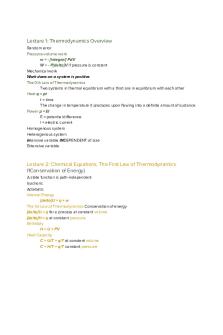
CHEM303 final exam review
- 4 Pages

Psychology Final Exam - Review
- 13 Pages
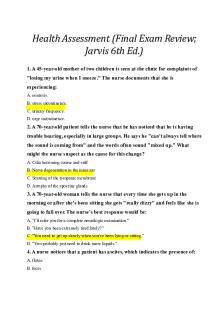
Jarvis Final Exam Review
- 12 Pages
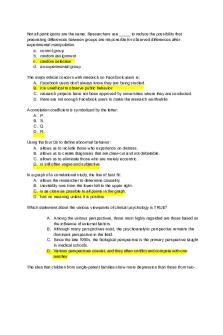
Final exam review
- 96 Pages
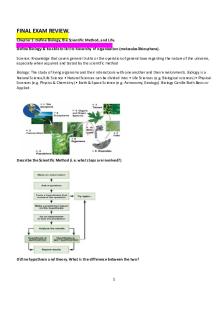
Final Exam Review
- 48 Pages
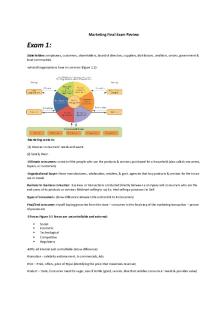
Marketing Final Exam Review
- 15 Pages
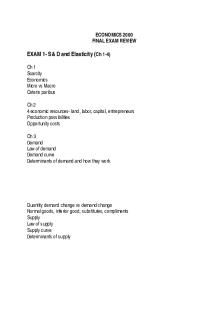
Final exam review
- 8 Pages
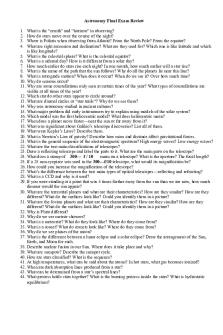
Astronomy Final Exam Review
- 2 Pages
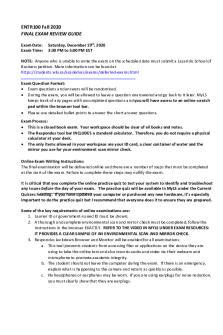
Final Exam Review Guide
- 4 Pages

Final exam review flsp4420
- 5 Pages

Theo Final Exam Review
- 16 Pages

Entrepreneurship final exam review
- 33 Pages
Popular Institutions
- Tinajero National High School - Annex
- Politeknik Caltex Riau
- Yokohama City University
- SGT University
- University of Al-Qadisiyah
- Divine Word College of Vigan
- Techniek College Rotterdam
- Universidade de Santiago
- Universiti Teknologi MARA Cawangan Johor Kampus Pasir Gudang
- Poltekkes Kemenkes Yogyakarta
- Baguio City National High School
- Colegio san marcos
- preparatoria uno
- Centro de Bachillerato Tecnológico Industrial y de Servicios No. 107
- Dalian Maritime University
- Quang Trung Secondary School
- Colegio Tecnológico en Informática
- Corporación Regional de Educación Superior
- Grupo CEDVA
- Dar Al Uloom University
- Centro de Estudios Preuniversitarios de la Universidad Nacional de Ingeniería
- 上智大学
- Aakash International School, Nuna Majara
- San Felipe Neri Catholic School
- Kang Chiao International School - New Taipei City
- Misamis Occidental National High School
- Institución Educativa Escuela Normal Juan Ladrilleros
- Kolehiyo ng Pantukan
- Batanes State College
- Instituto Continental
- Sekolah Menengah Kejuruan Kesehatan Kaltara (Tarakan)
- Colegio de La Inmaculada Concepcion - Cebu